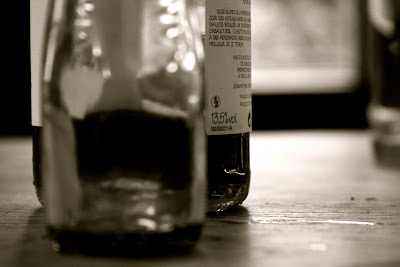Good Design
arranging and composing vignettes
We were challenged to create vignettes, using principles of good design to compose our images and arrange the objects within the frame in a visually appealing way.
I chose these three completely unrelated objects and tried to arrange a relationship between them
I put the three objects on a black tablecloth with a subtle pattern of twigs and leaves. This pattern emphasizes the dead leaf that gets the main focus in the foreground. The curve of its stem crosses the curves in the pattern in an attractive way. The antique copper bell is more (but not quite) centered in the frame, slightly out of focus and only a small part of it's stem is visible. The copper coins are spread in a blurry half-circle around the bell, they lead the eye out of the frame and away from the foreground, while at the same time repeating the curves of the leaf and the bell. The choice of objects (dead leaf, copper bell, money) and the way they are styled here allows viewers to give their own meaning to the image.
After this assignment using inamimate objects I tried to 'style' nature


I took a shot of these drops clinging to the umbel of a decaying hogweed, using a shallow DoF (with an iphone this is possible with the 'tap to focus' feature) to create a dreamy athmosphere. The next shot I took when I accidentally brushed the hogweed and the drop fell. This time I focused on the background, so the falling drop became blurry, creating a completely different visual effect.
For the second assignment we needed to style just one object, effectively using all the external factors like light, shadow, surface, lines, DoF, positioning and framing to create a compelling vignette.
This is an urn that contains the ashes of some of our pets that died over the past years. I tried to style and frame it in a way that conveys some of it's significance. I used the light above the table to accentuate the dust on the lid. The light gives the surface of the table and the blurry background a nice warm orange glow, which 'suits' the deep blue of the urn. The other lights in the room make starry reflections in the lacquered coating of the urn and turn the mother of pearl of the butterflies into gold. The lights also 'sculpt' the urn with a thin shiny curve around the top right that separates the urn from the background. There is a nice round shadow on the table and a small diagonal of light in the bottom of the frame. The horizontal line that separates the lighted surface of the table from the shadowed background forms the perfect 'horizon' dividing the frame. All these elements work together to give a deeper meaning to the shot.
One morning sunlight fell on the table through a glass of water and I tried to capture, style and frame the beautiful reflections, using all of the design-principles to arrange the shot
The left shot's main focus is on the reflection of the light within the long rectangle of shadow. The frame is divided into 3 slightly diagonal parts. The blurry circle of light in the background overlaps part of the middle rectangle and only a small part of the glass is visible.
The image on the right shows more of the glass, dividing the frame differently. One third of the frame is filled by the glass and the rest of the frame is divided in two by the diagonal line between the shadow and the rest of the table. The blurry circle of light now does not intrude upon the shadow, but stays in it's own area. All in all this gives the image a more balanced feel.
Since design was on my mind all the time during this week, I started to see it's use and effect everywhere. Here are two shots I took while shopping in Den Haag. Two completely differently designed shopwindows.
The left shot is of a bakery selling confectionery for the feast of Sinterklaas. It is very busy, colorful and full of curves, and particularly attractive to children. The other one is of a furniture shop, very tranquil, almost monochromatic in color, lots of straight lines and empty space.
I am crazy about machines. One day i spotted one right in the middle of a field and I stumbled down a slope to study it's design up close.
I really love all the tubes and cylinders and pipes and screws and all the red covered with black tarry soot and drops of water. A machine might be the most well designed thing ever.....! In any case somebody really spent a lot of time thinking about its design and it is absolutely very deliberate and purposeful. I love how that shows in all the little details in this collage.





















































